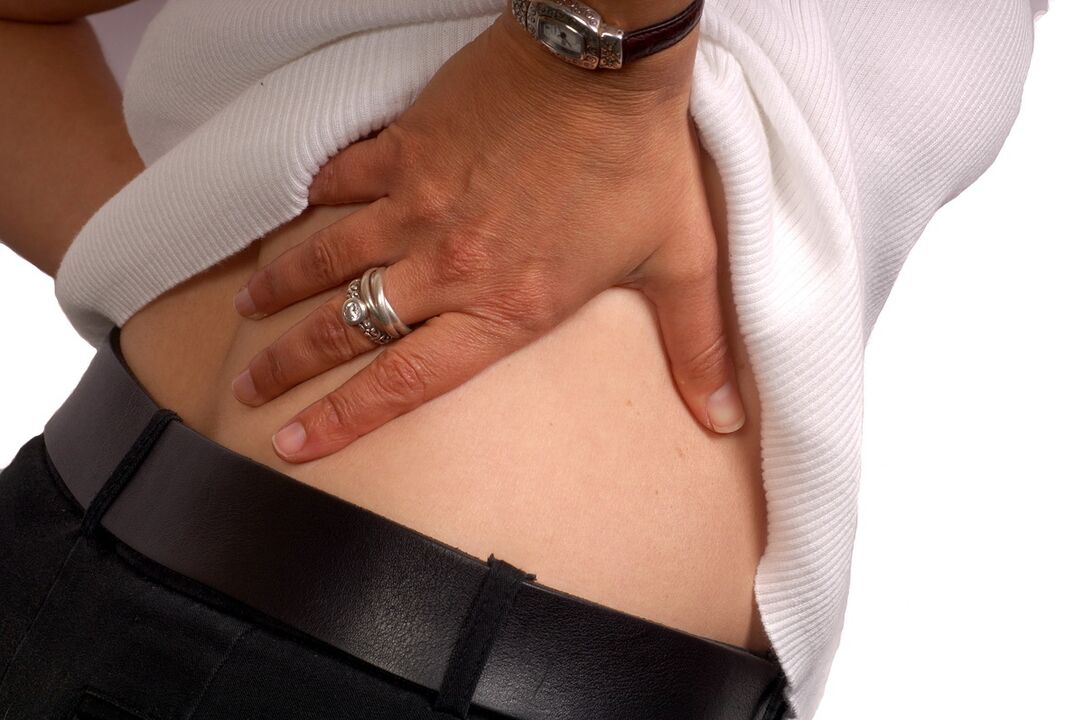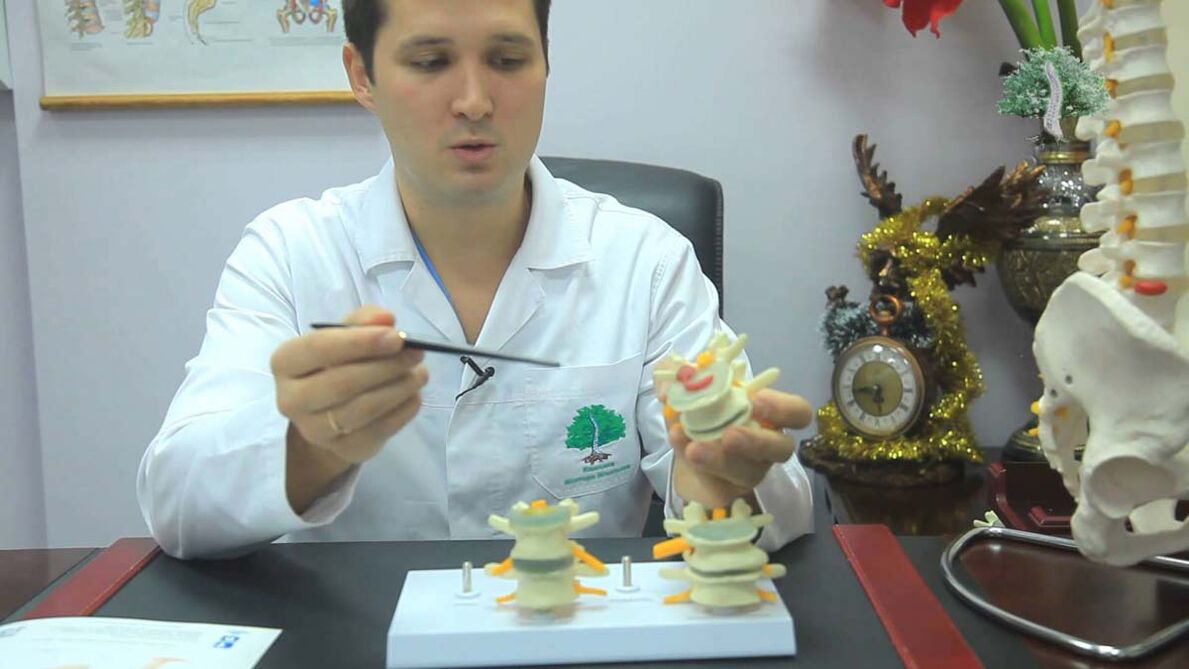Osteochondrosis of the lumbar spine is expressed by dystrophic lesions of the above-mentioned part of the back, lesions of the nucleus of the intervertebral discs and deformation of the intervertebral joints against the background of disorders of the ligament apparatus. In this pathological process in the later stages of the disease, the vessels are involved, and even the nervous system.
What is lumbar osteochondrosis?
Osteochondrosis of the lumbar spine is one of the most common diseases of the musculoskeletal system in the world. Irregular pain syndromes in the designated area are experienced by up to sixty percent of the population, and one in ten residents are diagnosed with osteochondrosis in one form or another, almost half of cases are due to defeatof the lumbar and sacral regions.

This disease quickly "rejuvenates", sometimes occurring even in adolescents and children - it is the fault of a sedentary lifestyle / work, as well as an excessive passion for computer games, a lack ofcomplete physical activity - sports and active games are supplanted by a long stay at the PC.
However, osteochondrosis of the lumbar spine can also occur due to excessive stress, especially if it is made worse by being overweight. The problem is caused by poor posture, as well as back injuries, non-compliance with the daily diet and systematic malnutrition.
Negative factors that accelerate the formation of prerequisites for the emergence of this type of osteochondrosis are chronic lack of sleep, stress, slowing of metabolic processes in the body. A separate category is that of professional athletes.

A number of specialists note that in some cases osteochondrosis is a consequence of the genetic predisposition of a person: the intervertebral discs, at the same time, have a loose pore structure, and under the influence of pathogenic negative factors arevery quickly destroyed, the disease progresses rapidly and is diagnosed only at late stages, sometimes irreversible.
A particular risk group are people with rheumatoid arthritis, as well as ankylosing spondylitis, which causes the development and complicates the course of the aforementioned autoimmune disease.
First signs. Symptoms of lumbar osteochondrosis
The main symptoms of the disease described above, of course, include pain syndrome. A prolonged painful pain in the lumbar region of moderate intensity, can be replaced by a strong "lumbago", after active physical work or an awkward position. As a rule, when lying down, the pain syndrome practically does not appear or disappears completely.

With exacerbation, as well as heavy physical exertion, hypothermia or non-physiological movements, the pain syndrome loses its localization in the lower back and goes to the pelvic region and even the legs.
In detail, the patient develops the following pathologies:
Compression of nerve roots
- Root lesions L 1-2: pain in local areas, loss of sensation in the inner thigh and groin.
- L-5 lesion: lumbar pain in the lower back, irradiation to the thumb.
- S-1 lesion: pain and numbness on the outer side of the thigh, foot, temporary disappearance of reflexes on the soles of the feet and lower leg.
Arterial injury
Local damage to the DH artery causes:
- Regular numbness in lower leg / buttocks.
- Loss of sensitivity in the genital area.
- In rare cases, loss of pelvic motor function.
Vascular compression ischemia
Violation of the blood supply to the spinal cord and additional peripheral structures leads to "thinning" of the structure of the intervertebral discs and, as a result, abnormal mobility of the spine, the formation of osteophytes and neoarthrosis.
Compressive myelopathy
The narrowing of the spinal canal causes periodic paroxysmal weakness of the extremities, a painful "lumbar" syndrome of the lower back with receding towards the back of the thighs. In this context, hypotrophy / hypotension of the gastrocnemius / gluteal muscles develops, the disappearance of plantar, anal and Achilles reflexes, paresis of the foot.
Treatment of osteochondrosis of the lumbar spine

It is possible and necessary to treat the disease. Naturally, in this case, only complex therapy will help, which is aimed at reducing the symptoms of an autoimmune disease, restoring the structure of the spine and preventing the recurrence of the problem.
The complex treatment of the above disease includes:
- To take pills.
- Blocking of injections.
- Gymnastics and exercise therapy.
- Massages and manual therapy.
- Physiotherapy.
Preparations for lumbar osteochondrosis
- Pain relief.
- Restoration of chondroprotectors.
- Vitamins. Optimal - group B.
- Injections. Anesthetics, cartilage restorers and blood microcirculation normalizers.
- Local funds. Corticosteroids as well as anti-inflammatory drugs.
Gymnastics for osteochondrosis of the lumbar spine
An important part of spinal rehabilitation. All procedures are developed individually, aimed at relieving pain and muscle spasms, normalizing blood circulation and restoring the work of the intervertebral discs.
Massage for osteochondrosis of the lumbar spine
Massage is an indispensable part of the complex therapy of the disease. It helps both relax and train lower back muscles, induces cartilage tissue repair process and relieves pain.
Most often, with the disease described above, therapeutic, acupressure, hardware, vacuum and connective tissue massage is used.
Physiotherapy
As a rule, physiotherapy is prescribed to patients with osteochondrosis of the lumbar spine only at the stage of remission of the disease, after overcoming the period of exacerbation of the problem.
Modern and classic techniques:
- Acupuncture. Exposure to acupuncture points on the back with special needles.
- Elongation. The classic technique of stretching the spine on a massage-traction table, performed by a qualified chiropractor.
- Electrophoresis. Known since the 60s, a complex non-operative method for influencing affected external problematic areas.
- Traction decompression. Automated spine stretching in a special medical complex.
- Shock wave therapy. The use of infrasound waves for the treatment of osteochondrosis.
- Osteopathy. A complex technique that combines elements of chiropractic, massage and therapeutic orthopedics.
- Magnetopuncture. Direct effect of an alternating magnetic field on the spine.
- Laser perforation. Treatment of acupuncture points with an induced beam of radiation.
- Electrical stimulation. The use of small alternating currents in the affected areas.
Prevention of lumbar osteochondrosis

After undergoing complex treatment and physiotherapy, supportive therapy is required for a long time: during this period, the spine is further weakened and needs support. In addition, prevention aims to prevent the occurrence of osteochondrosis of the lumbar spine. Main activities:
- Regular and balanced exercise, preferably under the supervision of a certified podiatrist.
- Normalization of body weight: quite often an overweight person is an aggravating factor affecting the formation of osteochondrosis.
- Diet correction. A regular diet should include foods rich in elements such as calcium and magnesium. In this case, it is worth excluding foods that are too fatty and unhealthy, as well as other foods that do not fall under the definition of healthy food.
- Rejection of bad habits. Alcohol and smoking intensify all destructive processes in the body, this also applies to the appearance of osteochondrosis.
- Correct posture. Be sure to watch your posture, especially if your job involves constantly being at the computer or sitting. Also pay attention to your child - how and for how long he or she sits. Correct normal posture will allow you to prevent the onset of scoliosis and hence osteochondrosis in the future.
- Use appropriate shoes, clothing and accessories, avoiding regular weight bearing. The wrong shoes, a heavy bag on the shoulder, work like a loader - sometimes all of these factors have a decisive influence on the onset of the formation of destructive processes in the spine.
Question Answer
What type of pain occurs with this type of osteochondrosis?
Lumbar spine osteochondrosis is characterized by several types of pain. First of all, these are unpleasant sensations localized in the lumbar region, continuing for a long time and significantly increasing with the increase in motor activity and physical work of a person. This type of pain goes away if the body is placed in a horizontal position for at least 15 to 20 minutes.
If the disease is exacerbated due to hypothermia, prolonged and intense physiological stress or sudden "eversion" movements, then in addition to the aforementioned background pain, there is also a localized "pulling" effect. in the pelvic region and radiating downward extremities.
Is gymnastics useful for this osteochondrosis?
Therapeutic gymnastics through exercise allows you to consolidate the good effect of complex therapy of the disease, partially develop the intervertebral components of the joints and relax / train the muscles of the lumbar region. In addition, regular and correct massage helps to get rid of the unpleasant pain associated with osteochondrosis.
A set and list of specific exercises, the number of approaches and the frequency of exercises are worked out for you by the attending physician: it will take into account the current stage of the disease, a possible list of contraindications and restrictions, the patient's condition and recommend methods for using exercise therapy in practice.

























